INF 80018 Enterprise Architecture: Literature Review on Relationships
VerifiedAdded on 2022/10/14
|17
|4629
|8
Literature Review
AI Summary
This assignment presents a literature review focusing on enterprise architecture (EA) and the crucial relationships between architects and stakeholders. It addresses the challenges in enterprise architecture, including translating actions into business benefits and establishing the value of EA among stakeholders. The review explores the importance of understanding the relational aspects of EA, stakeholder classification, and the roles of various stakeholders in the EA process. It highlights the need for efficient collaboration between architects and stakeholders and examines how authors have addressed these relationships within the existing body of EA research. The review also touches upon the application of enterprise architecture in large organizations and the factors contributing to its success or failure.
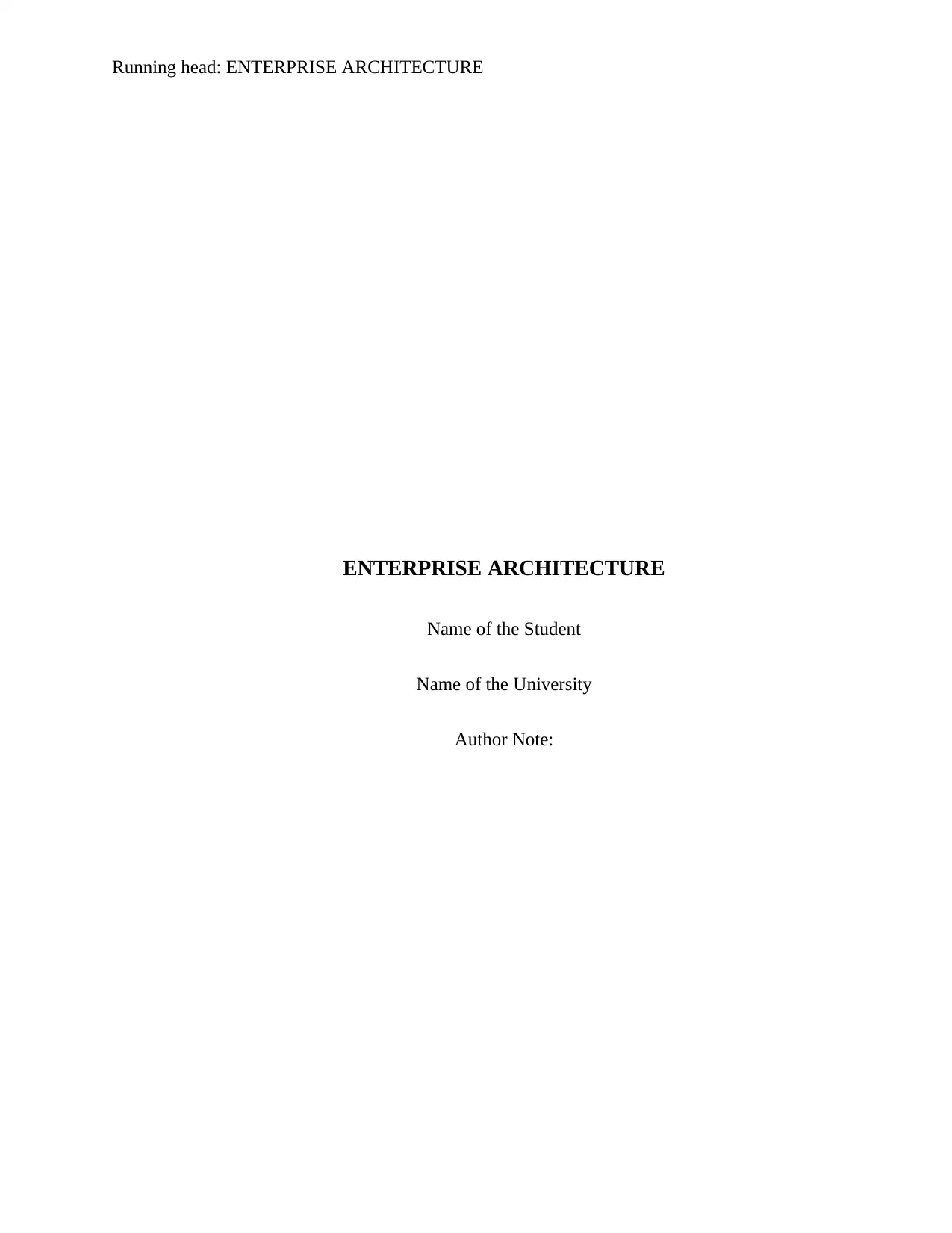
Running head: ENTERPRISE ARCHITECTURE
ENTERPRISE ARCHITECTURE
Name of the Student
Name of the University
Author Note:
ENTERPRISE ARCHITECTURE
Name of the Student
Name of the University
Author Note:
Paraphrase This Document
Need a fresh take? Get an instant paraphrase of this document with our AI Paraphraser
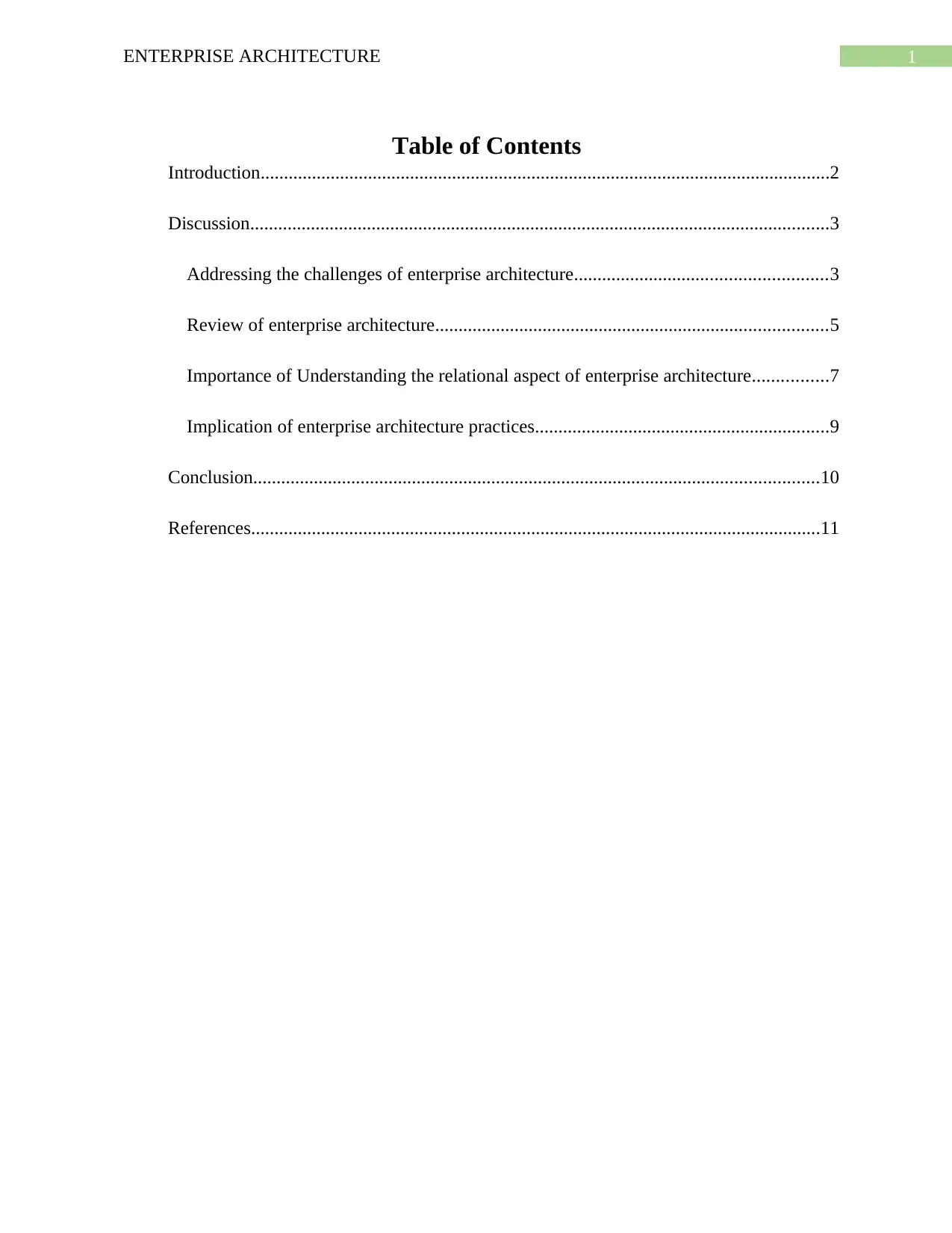
1ENTERPRISE ARCHITECTURE
Table of Contents
Introduction..........................................................................................................................2
Discussion............................................................................................................................3
Addressing the challenges of enterprise architecture......................................................3
Review of enterprise architecture....................................................................................5
Importance of Understanding the relational aspect of enterprise architecture................7
Implication of enterprise architecture practices...............................................................9
Conclusion.........................................................................................................................10
References..........................................................................................................................11
Table of Contents
Introduction..........................................................................................................................2
Discussion............................................................................................................................3
Addressing the challenges of enterprise architecture......................................................3
Review of enterprise architecture....................................................................................5
Importance of Understanding the relational aspect of enterprise architecture................7
Implication of enterprise architecture practices...............................................................9
Conclusion.........................................................................................................................10
References..........................................................................................................................11
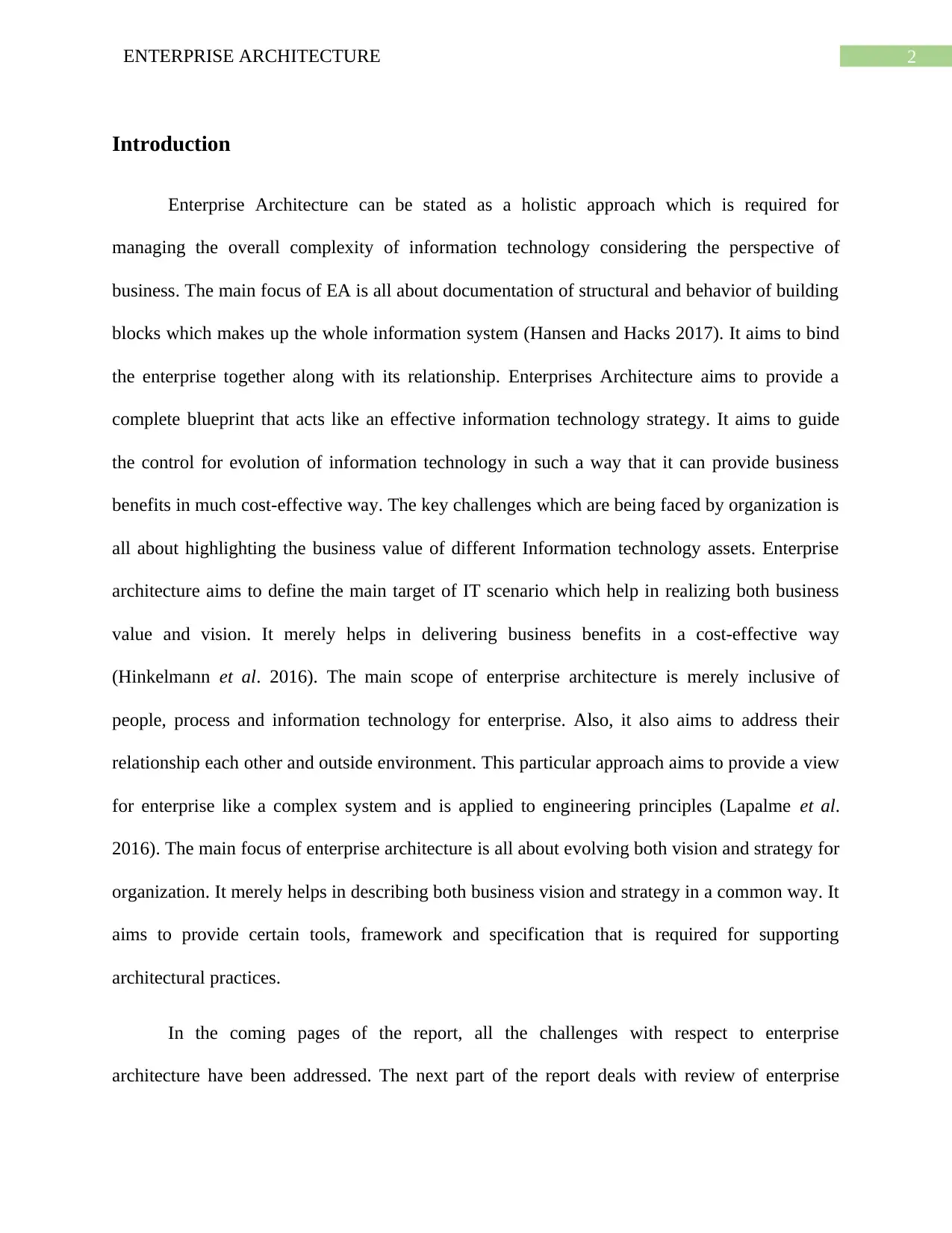
2ENTERPRISE ARCHITECTURE
Introduction
Enterprise Architecture can be stated as a holistic approach which is required for
managing the overall complexity of information technology considering the perspective of
business. The main focus of EA is all about documentation of structural and behavior of building
blocks which makes up the whole information system (Hansen and Hacks 2017). It aims to bind
the enterprise together along with its relationship. Enterprises Architecture aims to provide a
complete blueprint that acts like an effective information technology strategy. It aims to guide
the control for evolution of information technology in such a way that it can provide business
benefits in much cost-effective way. The key challenges which are being faced by organization is
all about highlighting the business value of different Information technology assets. Enterprise
architecture aims to define the main target of IT scenario which help in realizing both business
value and vision. It merely helps in delivering business benefits in a cost-effective way
(Hinkelmann et al. 2016). The main scope of enterprise architecture is merely inclusive of
people, process and information technology for enterprise. Also, it also aims to address their
relationship each other and outside environment. This particular approach aims to provide a view
for enterprise like a complex system and is applied to engineering principles (Lapalme et al.
2016). The main focus of enterprise architecture is all about evolving both vision and strategy for
organization. It merely helps in describing both business vision and strategy in a common way. It
aims to provide certain tools, framework and specification that is required for supporting
architectural practices.
In the coming pages of the report, all the challenges with respect to enterprise
architecture have been addressed. The next part of the report deals with review of enterprise
Introduction
Enterprise Architecture can be stated as a holistic approach which is required for
managing the overall complexity of information technology considering the perspective of
business. The main focus of EA is all about documentation of structural and behavior of building
blocks which makes up the whole information system (Hansen and Hacks 2017). It aims to bind
the enterprise together along with its relationship. Enterprises Architecture aims to provide a
complete blueprint that acts like an effective information technology strategy. It aims to guide
the control for evolution of information technology in such a way that it can provide business
benefits in much cost-effective way. The key challenges which are being faced by organization is
all about highlighting the business value of different Information technology assets. Enterprise
architecture aims to define the main target of IT scenario which help in realizing both business
value and vision. It merely helps in delivering business benefits in a cost-effective way
(Hinkelmann et al. 2016). The main scope of enterprise architecture is merely inclusive of
people, process and information technology for enterprise. Also, it also aims to address their
relationship each other and outside environment. This particular approach aims to provide a view
for enterprise like a complex system and is applied to engineering principles (Lapalme et al.
2016). The main focus of enterprise architecture is all about evolving both vision and strategy for
organization. It merely helps in describing both business vision and strategy in a common way. It
aims to provide certain tools, framework and specification that is required for supporting
architectural practices.
In the coming pages of the report, all the challenges with respect to enterprise
architecture have been addressed. The next part of the report deals with review of enterprise
⊘ This is a preview!⊘
Do you want full access?
Subscribe today to unlock all pages.

Trusted by 1+ million students worldwide
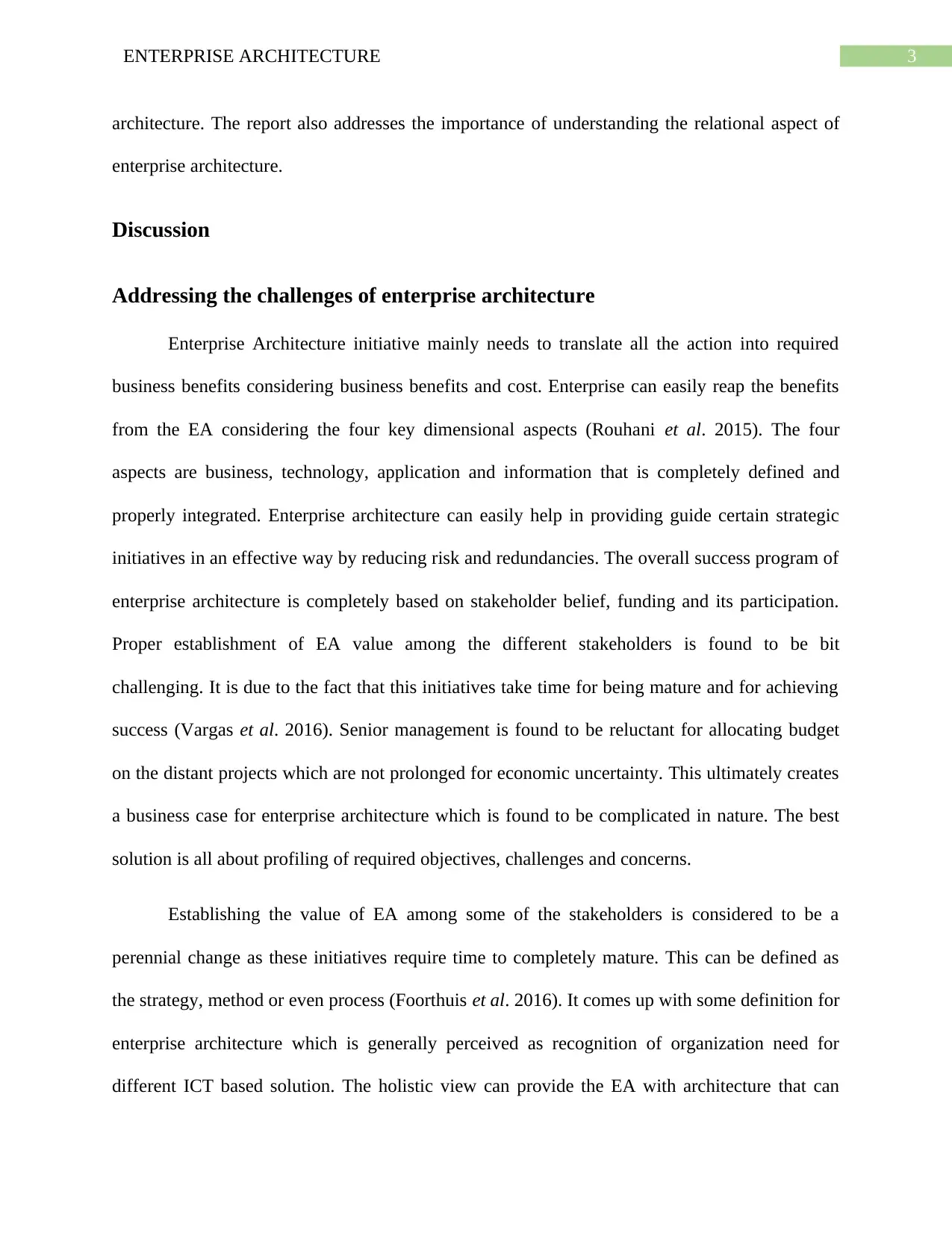
3ENTERPRISE ARCHITECTURE
architecture. The report also addresses the importance of understanding the relational aspect of
enterprise architecture.
Discussion
Addressing the challenges of enterprise architecture
Enterprise Architecture initiative mainly needs to translate all the action into required
business benefits considering business benefits and cost. Enterprise can easily reap the benefits
from the EA considering the four key dimensional aspects (Rouhani et al. 2015). The four
aspects are business, technology, application and information that is completely defined and
properly integrated. Enterprise architecture can easily help in providing guide certain strategic
initiatives in an effective way by reducing risk and redundancies. The overall success program of
enterprise architecture is completely based on stakeholder belief, funding and its participation.
Proper establishment of EA value among the different stakeholders is found to be bit
challenging. It is due to the fact that this initiatives take time for being mature and for achieving
success (Vargas et al. 2016). Senior management is found to be reluctant for allocating budget
on the distant projects which are not prolonged for economic uncertainty. This ultimately creates
a business case for enterprise architecture which is found to be complicated in nature. The best
solution is all about profiling of required objectives, challenges and concerns.
Establishing the value of EA among some of the stakeholders is considered to be a
perennial change as these initiatives require time to completely mature. This can be defined as
the strategy, method or even process (Foorthuis et al. 2016). It comes up with some definition for
enterprise architecture which is generally perceived as recognition of organization need for
different ICT based solution. The holistic view can provide the EA with architecture that can
architecture. The report also addresses the importance of understanding the relational aspect of
enterprise architecture.
Discussion
Addressing the challenges of enterprise architecture
Enterprise Architecture initiative mainly needs to translate all the action into required
business benefits considering business benefits and cost. Enterprise can easily reap the benefits
from the EA considering the four key dimensional aspects (Rouhani et al. 2015). The four
aspects are business, technology, application and information that is completely defined and
properly integrated. Enterprise architecture can easily help in providing guide certain strategic
initiatives in an effective way by reducing risk and redundancies. The overall success program of
enterprise architecture is completely based on stakeholder belief, funding and its participation.
Proper establishment of EA value among the different stakeholders is found to be bit
challenging. It is due to the fact that this initiatives take time for being mature and for achieving
success (Vargas et al. 2016). Senior management is found to be reluctant for allocating budget
on the distant projects which are not prolonged for economic uncertainty. This ultimately creates
a business case for enterprise architecture which is found to be complicated in nature. The best
solution is all about profiling of required objectives, challenges and concerns.
Establishing the value of EA among some of the stakeholders is considered to be a
perennial change as these initiatives require time to completely mature. This can be defined as
the strategy, method or even process (Foorthuis et al. 2016). It comes up with some definition for
enterprise architecture which is generally perceived as recognition of organization need for
different ICT based solution. The holistic view can provide the EA with architecture that can
Paraphrase This Document
Need a fresh take? Get an instant paraphrase of this document with our AI Paraphraser
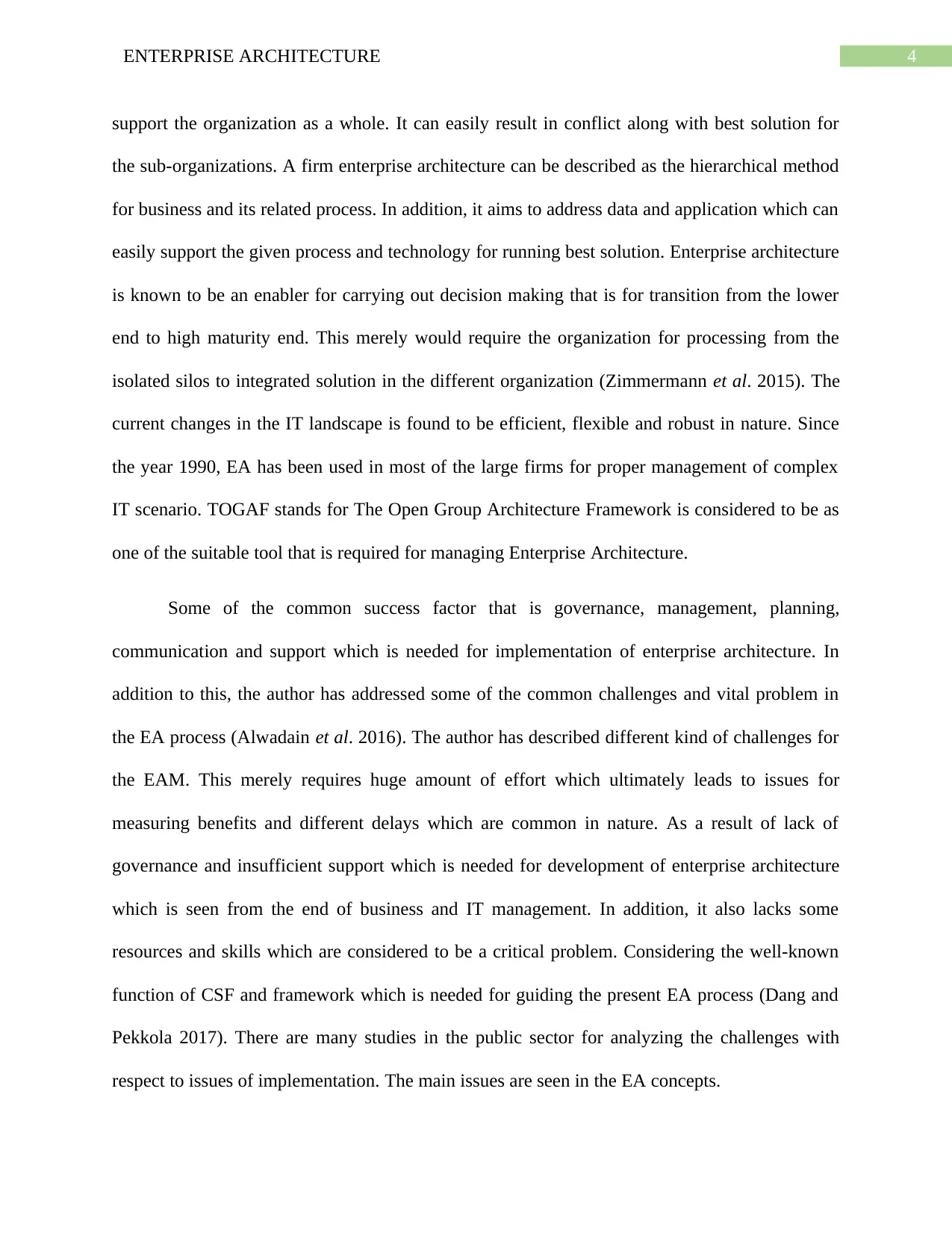
4ENTERPRISE ARCHITECTURE
support the organization as a whole. It can easily result in conflict along with best solution for
the sub-organizations. A firm enterprise architecture can be described as the hierarchical method
for business and its related process. In addition, it aims to address data and application which can
easily support the given process and technology for running best solution. Enterprise architecture
is known to be an enabler for carrying out decision making that is for transition from the lower
end to high maturity end. This merely would require the organization for processing from the
isolated silos to integrated solution in the different organization (Zimmermann et al. 2015). The
current changes in the IT landscape is found to be efficient, flexible and robust in nature. Since
the year 1990, EA has been used in most of the large firms for proper management of complex
IT scenario. TOGAF stands for The Open Group Architecture Framework is considered to be as
one of the suitable tool that is required for managing Enterprise Architecture.
Some of the common success factor that is governance, management, planning,
communication and support which is needed for implementation of enterprise architecture. In
addition to this, the author has addressed some of the common challenges and vital problem in
the EA process (Alwadain et al. 2016). The author has described different kind of challenges for
the EAM. This merely requires huge amount of effort which ultimately leads to issues for
measuring benefits and different delays which are common in nature. As a result of lack of
governance and insufficient support which is needed for development of enterprise architecture
which is seen from the end of business and IT management. In addition, it also lacks some
resources and skills which are considered to be a critical problem. Considering the well-known
function of CSF and framework which is needed for guiding the present EA process (Dang and
Pekkola 2017). There are many studies in the public sector for analyzing the challenges with
respect to issues of implementation. The main issues are seen in the EA concepts.
support the organization as a whole. It can easily result in conflict along with best solution for
the sub-organizations. A firm enterprise architecture can be described as the hierarchical method
for business and its related process. In addition, it aims to address data and application which can
easily support the given process and technology for running best solution. Enterprise architecture
is known to be an enabler for carrying out decision making that is for transition from the lower
end to high maturity end. This merely would require the organization for processing from the
isolated silos to integrated solution in the different organization (Zimmermann et al. 2015). The
current changes in the IT landscape is found to be efficient, flexible and robust in nature. Since
the year 1990, EA has been used in most of the large firms for proper management of complex
IT scenario. TOGAF stands for The Open Group Architecture Framework is considered to be as
one of the suitable tool that is required for managing Enterprise Architecture.
Some of the common success factor that is governance, management, planning,
communication and support which is needed for implementation of enterprise architecture. In
addition to this, the author has addressed some of the common challenges and vital problem in
the EA process (Alwadain et al. 2016). The author has described different kind of challenges for
the EAM. This merely requires huge amount of effort which ultimately leads to issues for
measuring benefits and different delays which are common in nature. As a result of lack of
governance and insufficient support which is needed for development of enterprise architecture
which is seen from the end of business and IT management. In addition, it also lacks some
resources and skills which are considered to be a critical problem. Considering the well-known
function of CSF and framework which is needed for guiding the present EA process (Dang and
Pekkola 2017). There are many studies in the public sector for analyzing the challenges with
respect to issues of implementation. The main issues are seen in the EA concepts.
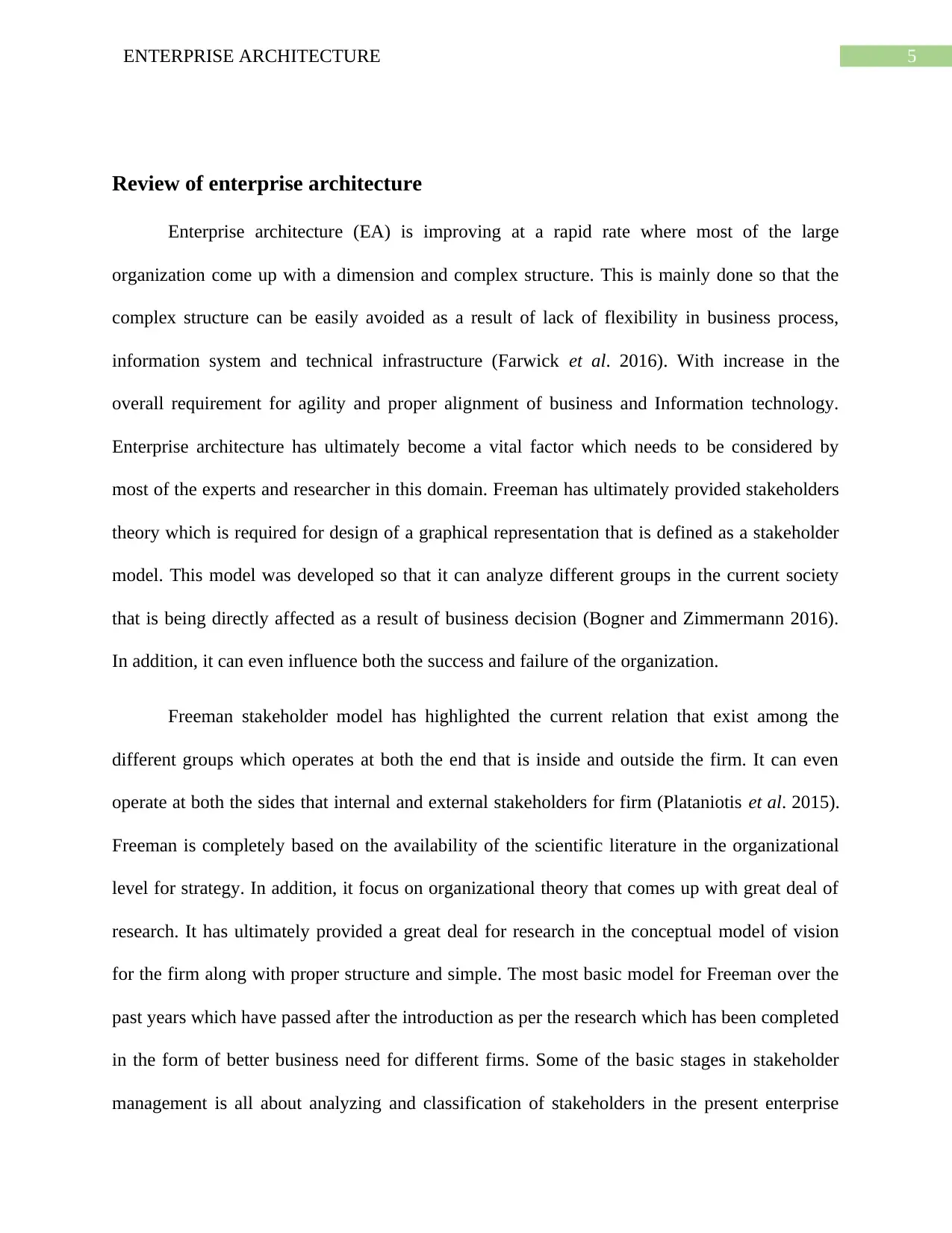
5ENTERPRISE ARCHITECTURE
Review of enterprise architecture
Enterprise architecture (EA) is improving at a rapid rate where most of the large
organization come up with a dimension and complex structure. This is mainly done so that the
complex structure can be easily avoided as a result of lack of flexibility in business process,
information system and technical infrastructure (Farwick et al. 2016). With increase in the
overall requirement for agility and proper alignment of business and Information technology.
Enterprise architecture has ultimately become a vital factor which needs to be considered by
most of the experts and researcher in this domain. Freeman has ultimately provided stakeholders
theory which is required for design of a graphical representation that is defined as a stakeholder
model. This model was developed so that it can analyze different groups in the current society
that is being directly affected as a result of business decision (Bogner and Zimmermann 2016).
In addition, it can even influence both the success and failure of the organization.
Freeman stakeholder model has highlighted the current relation that exist among the
different groups which operates at both the end that is inside and outside the firm. It can even
operate at both the sides that internal and external stakeholders for firm (Plataniotis et al. 2015).
Freeman is completely based on the availability of the scientific literature in the organizational
level for strategy. In addition, it focus on organizational theory that comes up with great deal of
research. It has ultimately provided a great deal for research in the conceptual model of vision
for the firm along with proper structure and simple. The most basic model for Freeman over the
past years which have passed after the introduction as per the research which has been completed
in the form of better business need for different firms. Some of the basic stages in stakeholder
management is all about analyzing and classification of stakeholders in the present enterprise
Review of enterprise architecture
Enterprise architecture (EA) is improving at a rapid rate where most of the large
organization come up with a dimension and complex structure. This is mainly done so that the
complex structure can be easily avoided as a result of lack of flexibility in business process,
information system and technical infrastructure (Farwick et al. 2016). With increase in the
overall requirement for agility and proper alignment of business and Information technology.
Enterprise architecture has ultimately become a vital factor which needs to be considered by
most of the experts and researcher in this domain. Freeman has ultimately provided stakeholders
theory which is required for design of a graphical representation that is defined as a stakeholder
model. This model was developed so that it can analyze different groups in the current society
that is being directly affected as a result of business decision (Bogner and Zimmermann 2016).
In addition, it can even influence both the success and failure of the organization.
Freeman stakeholder model has highlighted the current relation that exist among the
different groups which operates at both the end that is inside and outside the firm. It can even
operate at both the sides that internal and external stakeholders for firm (Plataniotis et al. 2015).
Freeman is completely based on the availability of the scientific literature in the organizational
level for strategy. In addition, it focus on organizational theory that comes up with great deal of
research. It has ultimately provided a great deal for research in the conceptual model of vision
for the firm along with proper structure and simple. The most basic model for Freeman over the
past years which have passed after the introduction as per the research which has been completed
in the form of better business need for different firms. Some of the basic stages in stakeholder
management is all about analyzing and classification of stakeholders in the present enterprise
⊘ This is a preview!⊘
Do you want full access?
Subscribe today to unlock all pages.

Trusted by 1+ million students worldwide
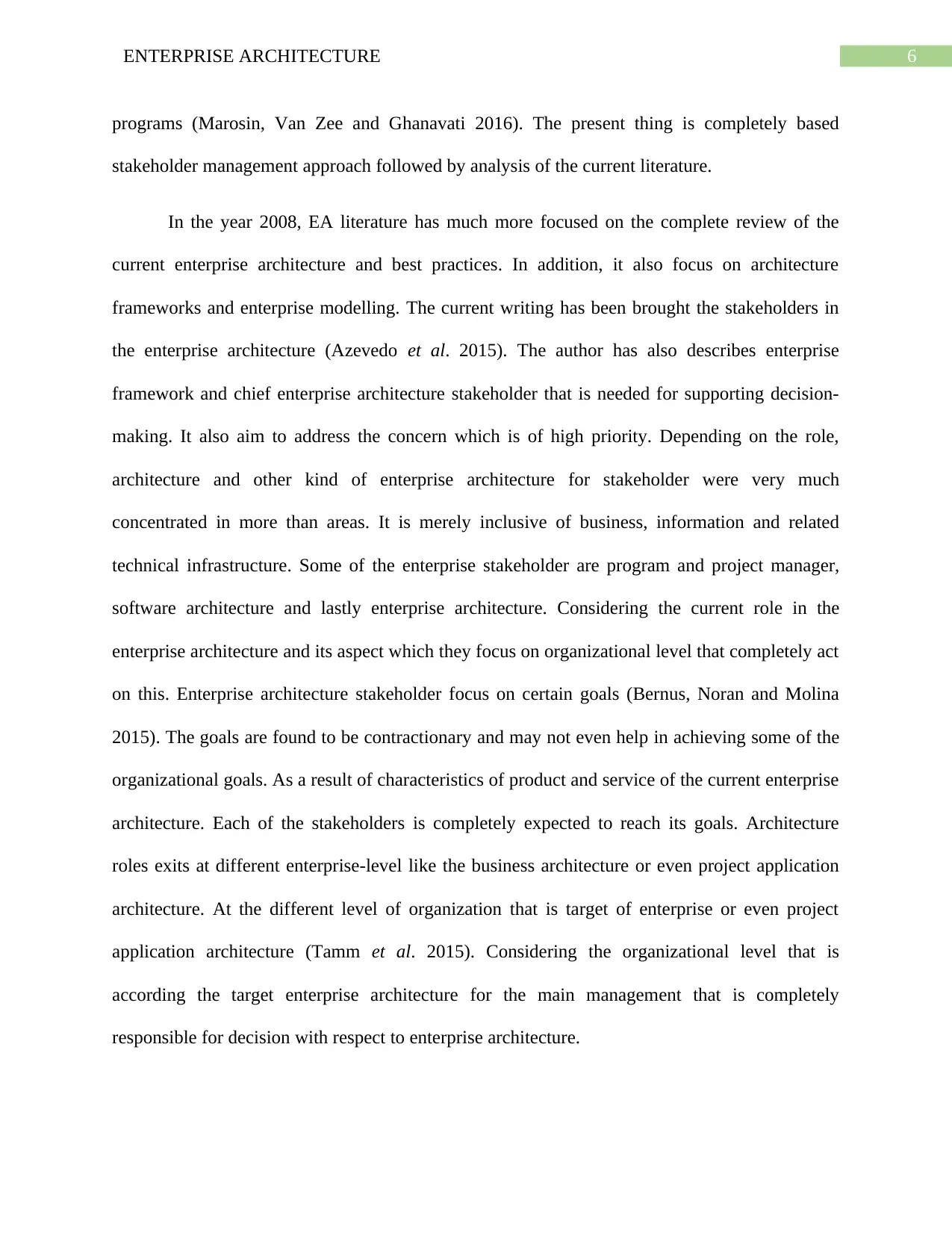
6ENTERPRISE ARCHITECTURE
programs (Marosin, Van Zee and Ghanavati 2016). The present thing is completely based
stakeholder management approach followed by analysis of the current literature.
In the year 2008, EA literature has much more focused on the complete review of the
current enterprise architecture and best practices. In addition, it also focus on architecture
frameworks and enterprise modelling. The current writing has been brought the stakeholders in
the enterprise architecture (Azevedo et al. 2015). The author has also describes enterprise
framework and chief enterprise architecture stakeholder that is needed for supporting decision-
making. It also aim to address the concern which is of high priority. Depending on the role,
architecture and other kind of enterprise architecture for stakeholder were very much
concentrated in more than areas. It is merely inclusive of business, information and related
technical infrastructure. Some of the enterprise stakeholder are program and project manager,
software architecture and lastly enterprise architecture. Considering the current role in the
enterprise architecture and its aspect which they focus on organizational level that completely act
on this. Enterprise architecture stakeholder focus on certain goals (Bernus, Noran and Molina
2015). The goals are found to be contractionary and may not even help in achieving some of the
organizational goals. As a result of characteristics of product and service of the current enterprise
architecture. Each of the stakeholders is completely expected to reach its goals. Architecture
roles exits at different enterprise-level like the business architecture or even project application
architecture. At the different level of organization that is target of enterprise or even project
application architecture (Tamm et al. 2015). Considering the organizational level that is
according the target enterprise architecture for the main management that is completely
responsible for decision with respect to enterprise architecture.
programs (Marosin, Van Zee and Ghanavati 2016). The present thing is completely based
stakeholder management approach followed by analysis of the current literature.
In the year 2008, EA literature has much more focused on the complete review of the
current enterprise architecture and best practices. In addition, it also focus on architecture
frameworks and enterprise modelling. The current writing has been brought the stakeholders in
the enterprise architecture (Azevedo et al. 2015). The author has also describes enterprise
framework and chief enterprise architecture stakeholder that is needed for supporting decision-
making. It also aim to address the concern which is of high priority. Depending on the role,
architecture and other kind of enterprise architecture for stakeholder were very much
concentrated in more than areas. It is merely inclusive of business, information and related
technical infrastructure. Some of the enterprise stakeholder are program and project manager,
software architecture and lastly enterprise architecture. Considering the current role in the
enterprise architecture and its aspect which they focus on organizational level that completely act
on this. Enterprise architecture stakeholder focus on certain goals (Bernus, Noran and Molina
2015). The goals are found to be contractionary and may not even help in achieving some of the
organizational goals. As a result of characteristics of product and service of the current enterprise
architecture. Each of the stakeholders is completely expected to reach its goals. Architecture
roles exits at different enterprise-level like the business architecture or even project application
architecture. At the different level of organization that is target of enterprise or even project
application architecture (Tamm et al. 2015). Considering the organizational level that is
according the target enterprise architecture for the main management that is completely
responsible for decision with respect to enterprise architecture.
Paraphrase This Document
Need a fresh take? Get an instant paraphrase of this document with our AI Paraphraser
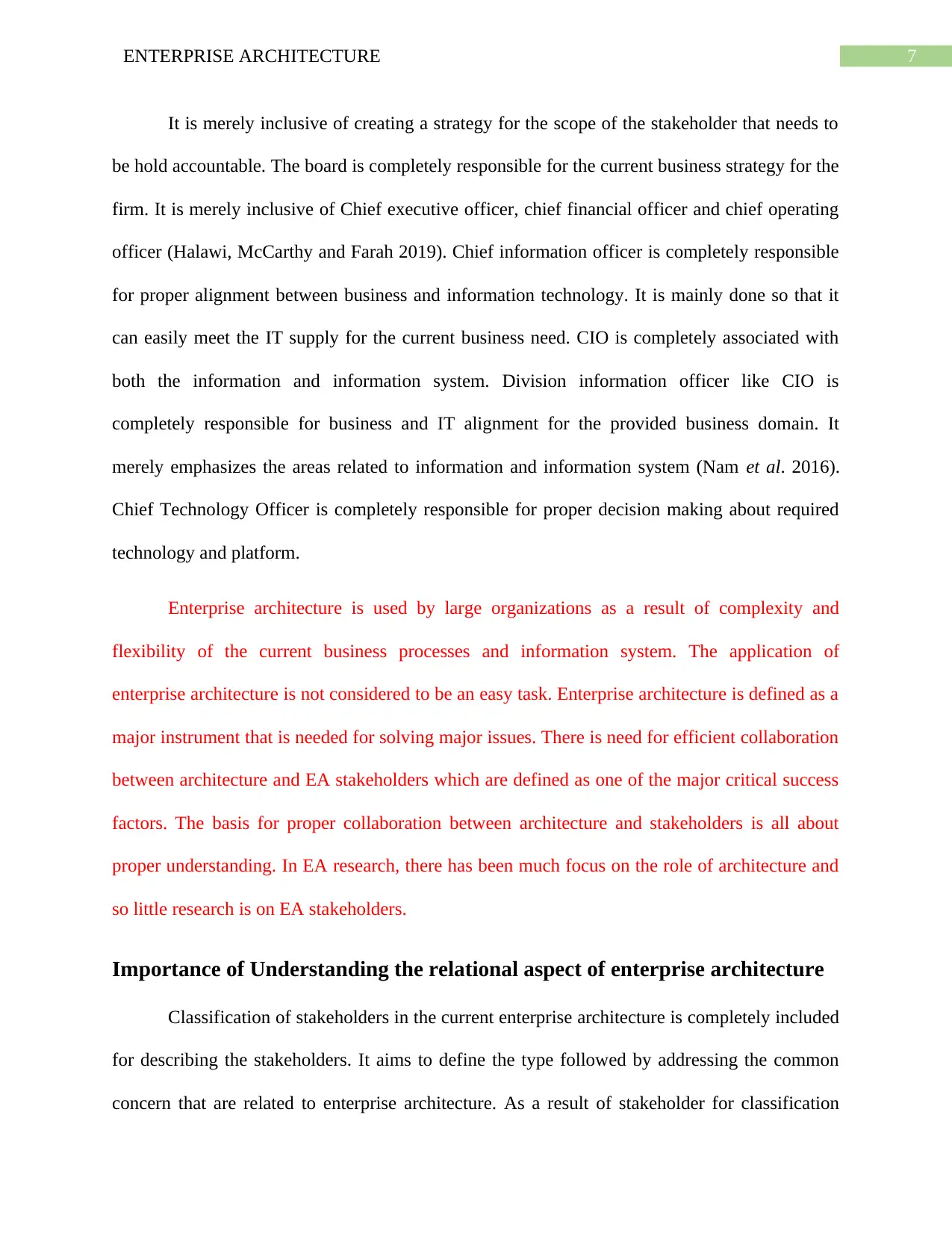
7ENTERPRISE ARCHITECTURE
It is merely inclusive of creating a strategy for the scope of the stakeholder that needs to
be hold accountable. The board is completely responsible for the current business strategy for the
firm. It is merely inclusive of Chief executive officer, chief financial officer and chief operating
officer (Halawi, McCarthy and Farah 2019). Chief information officer is completely responsible
for proper alignment between business and information technology. It is mainly done so that it
can easily meet the IT supply for the current business need. CIO is completely associated with
both the information and information system. Division information officer like CIO is
completely responsible for business and IT alignment for the provided business domain. It
merely emphasizes the areas related to information and information system (Nam et al. 2016).
Chief Technology Officer is completely responsible for proper decision making about required
technology and platform.
Enterprise architecture is used by large organizations as a result of complexity and
flexibility of the current business processes and information system. The application of
enterprise architecture is not considered to be an easy task. Enterprise architecture is defined as a
major instrument that is needed for solving major issues. There is need for efficient collaboration
between architecture and EA stakeholders which are defined as one of the major critical success
factors. The basis for proper collaboration between architecture and stakeholders is all about
proper understanding. In EA research, there has been much focus on the role of architecture and
so little research is on EA stakeholders.
Importance of Understanding the relational aspect of enterprise architecture
Classification of stakeholders in the current enterprise architecture is completely included
for describing the stakeholders. It aims to define the type followed by addressing the common
concern that are related to enterprise architecture. As a result of stakeholder for classification
It is merely inclusive of creating a strategy for the scope of the stakeholder that needs to
be hold accountable. The board is completely responsible for the current business strategy for the
firm. It is merely inclusive of Chief executive officer, chief financial officer and chief operating
officer (Halawi, McCarthy and Farah 2019). Chief information officer is completely responsible
for proper alignment between business and information technology. It is mainly done so that it
can easily meet the IT supply for the current business need. CIO is completely associated with
both the information and information system. Division information officer like CIO is
completely responsible for business and IT alignment for the provided business domain. It
merely emphasizes the areas related to information and information system (Nam et al. 2016).
Chief Technology Officer is completely responsible for proper decision making about required
technology and platform.
Enterprise architecture is used by large organizations as a result of complexity and
flexibility of the current business processes and information system. The application of
enterprise architecture is not considered to be an easy task. Enterprise architecture is defined as a
major instrument that is needed for solving major issues. There is need for efficient collaboration
between architecture and EA stakeholders which are defined as one of the major critical success
factors. The basis for proper collaboration between architecture and stakeholders is all about
proper understanding. In EA research, there has been much focus on the role of architecture and
so little research is on EA stakeholders.
Importance of Understanding the relational aspect of enterprise architecture
Classification of stakeholders in the current enterprise architecture is completely included
for describing the stakeholders. It aims to define the type followed by addressing the common
concern that are related to enterprise architecture. As a result of stakeholder for classification
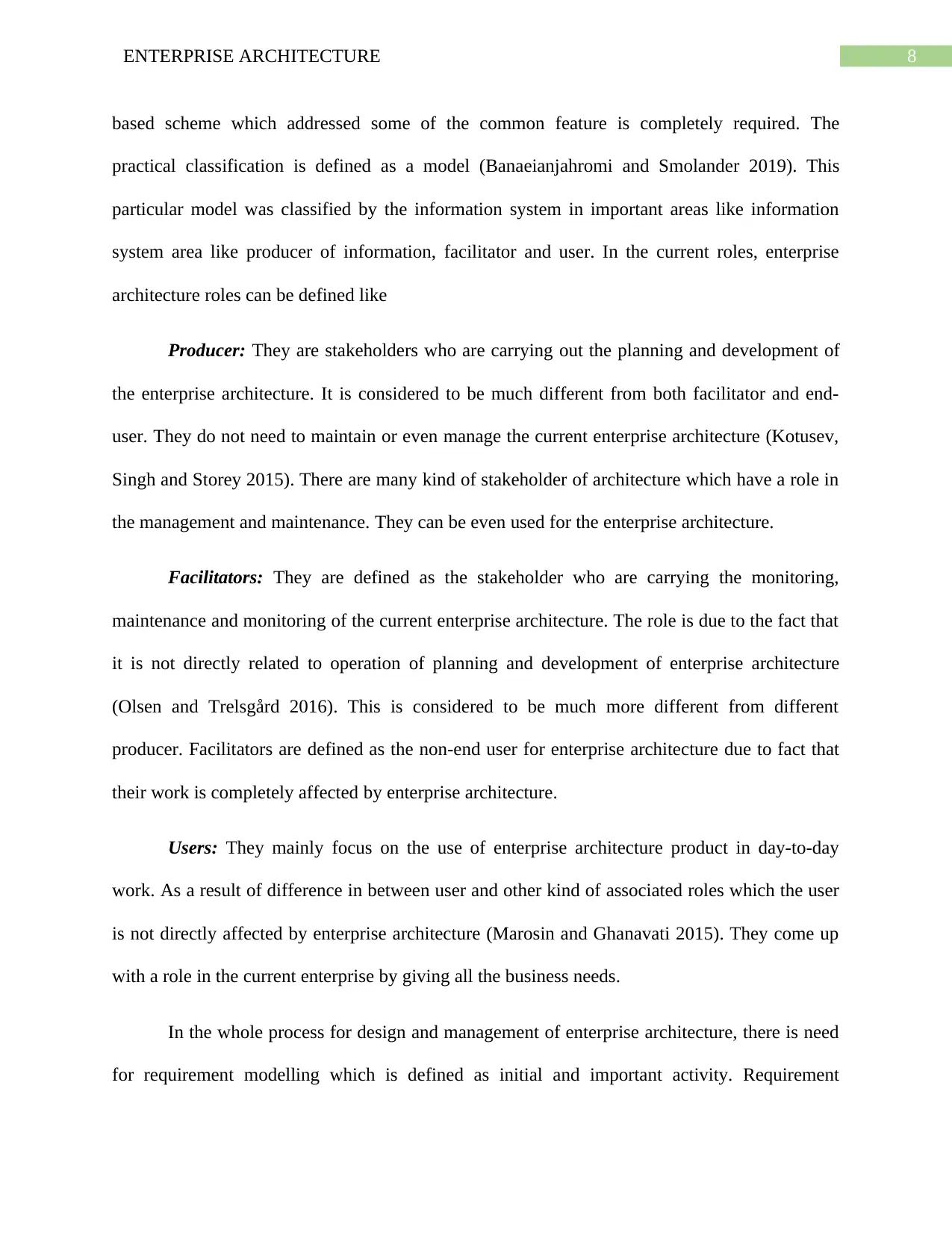
8ENTERPRISE ARCHITECTURE
based scheme which addressed some of the common feature is completely required. The
practical classification is defined as a model (Banaeianjahromi and Smolander 2019). This
particular model was classified by the information system in important areas like information
system area like producer of information, facilitator and user. In the current roles, enterprise
architecture roles can be defined like
Producer: They are stakeholders who are carrying out the planning and development of
the enterprise architecture. It is considered to be much different from both facilitator and end-
user. They do not need to maintain or even manage the current enterprise architecture (Kotusev,
Singh and Storey 2015). There are many kind of stakeholder of architecture which have a role in
the management and maintenance. They can be even used for the enterprise architecture.
Facilitators: They are defined as the stakeholder who are carrying the monitoring,
maintenance and monitoring of the current enterprise architecture. The role is due to the fact that
it is not directly related to operation of planning and development of enterprise architecture
(Olsen and Trelsgård 2016). This is considered to be much more different from different
producer. Facilitators are defined as the non-end user for enterprise architecture due to fact that
their work is completely affected by enterprise architecture.
Users: They mainly focus on the use of enterprise architecture product in day-to-day
work. As a result of difference in between user and other kind of associated roles which the user
is not directly affected by enterprise architecture (Marosin and Ghanavati 2015). They come up
with a role in the current enterprise by giving all the business needs.
In the whole process for design and management of enterprise architecture, there is need
for requirement modelling which is defined as initial and important activity. Requirement
based scheme which addressed some of the common feature is completely required. The
practical classification is defined as a model (Banaeianjahromi and Smolander 2019). This
particular model was classified by the information system in important areas like information
system area like producer of information, facilitator and user. In the current roles, enterprise
architecture roles can be defined like
Producer: They are stakeholders who are carrying out the planning and development of
the enterprise architecture. It is considered to be much different from both facilitator and end-
user. They do not need to maintain or even manage the current enterprise architecture (Kotusev,
Singh and Storey 2015). There are many kind of stakeholder of architecture which have a role in
the management and maintenance. They can be even used for the enterprise architecture.
Facilitators: They are defined as the stakeholder who are carrying the monitoring,
maintenance and monitoring of the current enterprise architecture. The role is due to the fact that
it is not directly related to operation of planning and development of enterprise architecture
(Olsen and Trelsgård 2016). This is considered to be much more different from different
producer. Facilitators are defined as the non-end user for enterprise architecture due to fact that
their work is completely affected by enterprise architecture.
Users: They mainly focus on the use of enterprise architecture product in day-to-day
work. As a result of difference in between user and other kind of associated roles which the user
is not directly affected by enterprise architecture (Marosin and Ghanavati 2015). They come up
with a role in the current enterprise by giving all the business needs.
In the whole process for design and management of enterprise architecture, there is need
for requirement modelling which is defined as initial and important activity. Requirement
⊘ This is a preview!⊘
Do you want full access?
Subscribe today to unlock all pages.

Trusted by 1+ million students worldwide
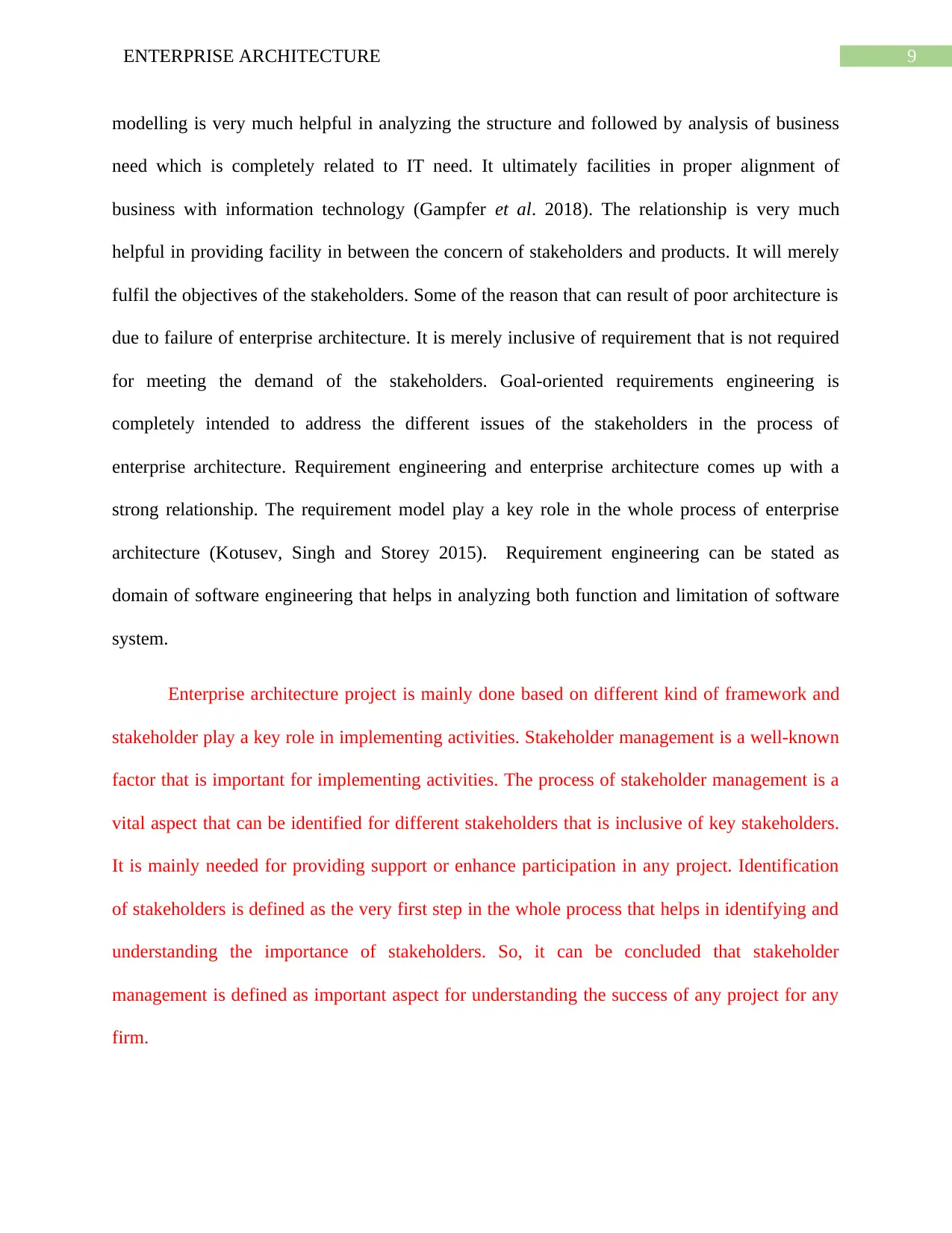
9ENTERPRISE ARCHITECTURE
modelling is very much helpful in analyzing the structure and followed by analysis of business
need which is completely related to IT need. It ultimately facilities in proper alignment of
business with information technology (Gampfer et al. 2018). The relationship is very much
helpful in providing facility in between the concern of stakeholders and products. It will merely
fulfil the objectives of the stakeholders. Some of the reason that can result of poor architecture is
due to failure of enterprise architecture. It is merely inclusive of requirement that is not required
for meeting the demand of the stakeholders. Goal-oriented requirements engineering is
completely intended to address the different issues of the stakeholders in the process of
enterprise architecture. Requirement engineering and enterprise architecture comes up with a
strong relationship. The requirement model play a key role in the whole process of enterprise
architecture (Kotusev, Singh and Storey 2015). Requirement engineering can be stated as
domain of software engineering that helps in analyzing both function and limitation of software
system.
Enterprise architecture project is mainly done based on different kind of framework and
stakeholder play a key role in implementing activities. Stakeholder management is a well-known
factor that is important for implementing activities. The process of stakeholder management is a
vital aspect that can be identified for different stakeholders that is inclusive of key stakeholders.
It is mainly needed for providing support or enhance participation in any project. Identification
of stakeholders is defined as the very first step in the whole process that helps in identifying and
understanding the importance of stakeholders. So, it can be concluded that stakeholder
management is defined as important aspect for understanding the success of any project for any
firm.
modelling is very much helpful in analyzing the structure and followed by analysis of business
need which is completely related to IT need. It ultimately facilities in proper alignment of
business with information technology (Gampfer et al. 2018). The relationship is very much
helpful in providing facility in between the concern of stakeholders and products. It will merely
fulfil the objectives of the stakeholders. Some of the reason that can result of poor architecture is
due to failure of enterprise architecture. It is merely inclusive of requirement that is not required
for meeting the demand of the stakeholders. Goal-oriented requirements engineering is
completely intended to address the different issues of the stakeholders in the process of
enterprise architecture. Requirement engineering and enterprise architecture comes up with a
strong relationship. The requirement model play a key role in the whole process of enterprise
architecture (Kotusev, Singh and Storey 2015). Requirement engineering can be stated as
domain of software engineering that helps in analyzing both function and limitation of software
system.
Enterprise architecture project is mainly done based on different kind of framework and
stakeholder play a key role in implementing activities. Stakeholder management is a well-known
factor that is important for implementing activities. The process of stakeholder management is a
vital aspect that can be identified for different stakeholders that is inclusive of key stakeholders.
It is mainly needed for providing support or enhance participation in any project. Identification
of stakeholders is defined as the very first step in the whole process that helps in identifying and
understanding the importance of stakeholders. So, it can be concluded that stakeholder
management is defined as important aspect for understanding the success of any project for any
firm.
Paraphrase This Document
Need a fresh take? Get an instant paraphrase of this document with our AI Paraphraser
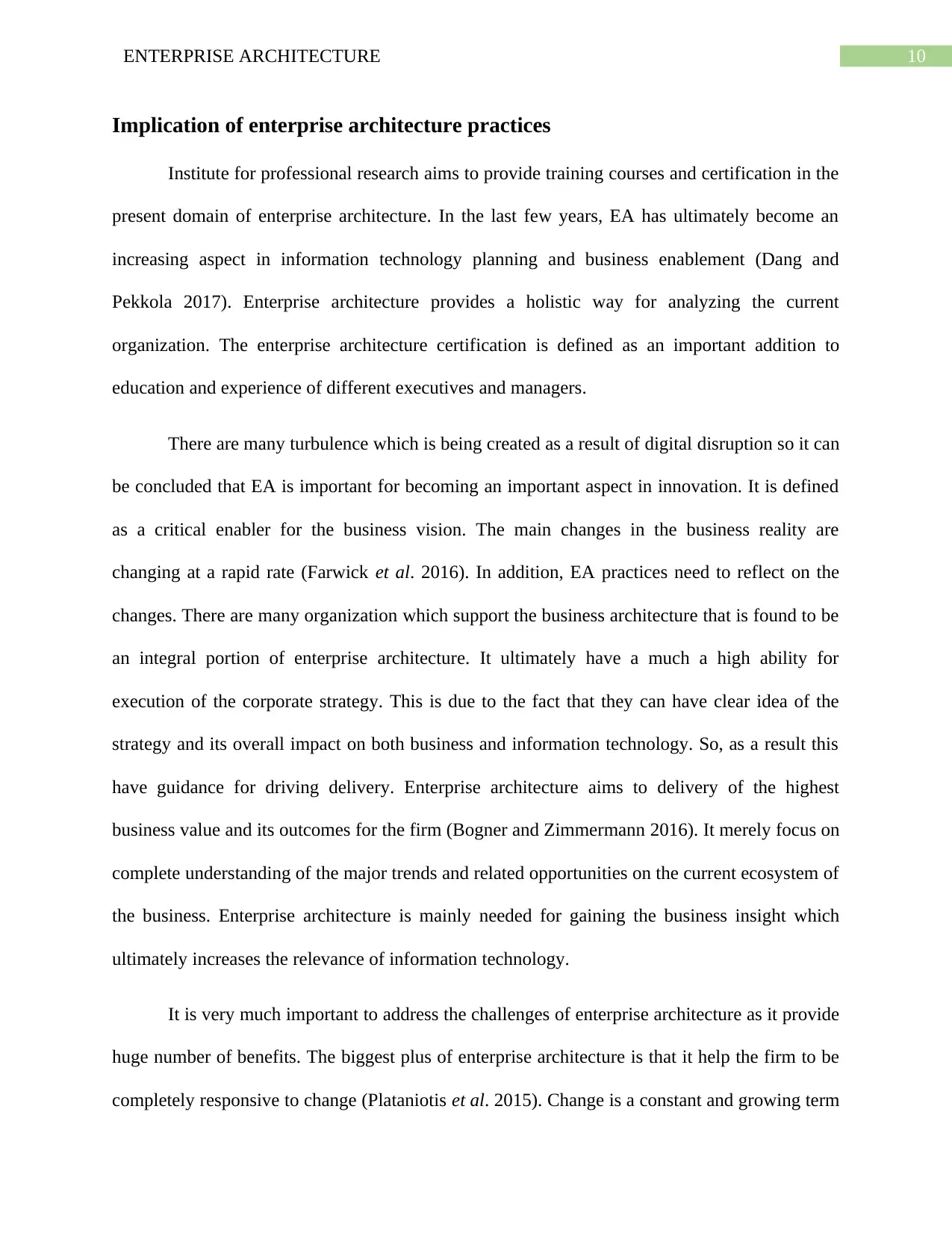
10ENTERPRISE ARCHITECTURE
Implication of enterprise architecture practices
Institute for professional research aims to provide training courses and certification in the
present domain of enterprise architecture. In the last few years, EA has ultimately become an
increasing aspect in information technology planning and business enablement (Dang and
Pekkola 2017). Enterprise architecture provides a holistic way for analyzing the current
organization. The enterprise architecture certification is defined as an important addition to
education and experience of different executives and managers.
There are many turbulence which is being created as a result of digital disruption so it can
be concluded that EA is important for becoming an important aspect in innovation. It is defined
as a critical enabler for the business vision. The main changes in the business reality are
changing at a rapid rate (Farwick et al. 2016). In addition, EA practices need to reflect on the
changes. There are many organization which support the business architecture that is found to be
an integral portion of enterprise architecture. It ultimately have a much a high ability for
execution of the corporate strategy. This is due to the fact that they can have clear idea of the
strategy and its overall impact on both business and information technology. So, as a result this
have guidance for driving delivery. Enterprise architecture aims to delivery of the highest
business value and its outcomes for the firm (Bogner and Zimmermann 2016). It merely focus on
complete understanding of the major trends and related opportunities on the current ecosystem of
the business. Enterprise architecture is mainly needed for gaining the business insight which
ultimately increases the relevance of information technology.
It is very much important to address the challenges of enterprise architecture as it provide
huge number of benefits. The biggest plus of enterprise architecture is that it help the firm to be
completely responsive to change (Plataniotis et al. 2015). Change is a constant and growing term
Implication of enterprise architecture practices
Institute for professional research aims to provide training courses and certification in the
present domain of enterprise architecture. In the last few years, EA has ultimately become an
increasing aspect in information technology planning and business enablement (Dang and
Pekkola 2017). Enterprise architecture provides a holistic way for analyzing the current
organization. The enterprise architecture certification is defined as an important addition to
education and experience of different executives and managers.
There are many turbulence which is being created as a result of digital disruption so it can
be concluded that EA is important for becoming an important aspect in innovation. It is defined
as a critical enabler for the business vision. The main changes in the business reality are
changing at a rapid rate (Farwick et al. 2016). In addition, EA practices need to reflect on the
changes. There are many organization which support the business architecture that is found to be
an integral portion of enterprise architecture. It ultimately have a much a high ability for
execution of the corporate strategy. This is due to the fact that they can have clear idea of the
strategy and its overall impact on both business and information technology. So, as a result this
have guidance for driving delivery. Enterprise architecture aims to delivery of the highest
business value and its outcomes for the firm (Bogner and Zimmermann 2016). It merely focus on
complete understanding of the major trends and related opportunities on the current ecosystem of
the business. Enterprise architecture is mainly needed for gaining the business insight which
ultimately increases the relevance of information technology.
It is very much important to address the challenges of enterprise architecture as it provide
huge number of benefits. The biggest plus of enterprise architecture is that it help the firm to be
completely responsive to change (Plataniotis et al. 2015). Change is a constant and growing term
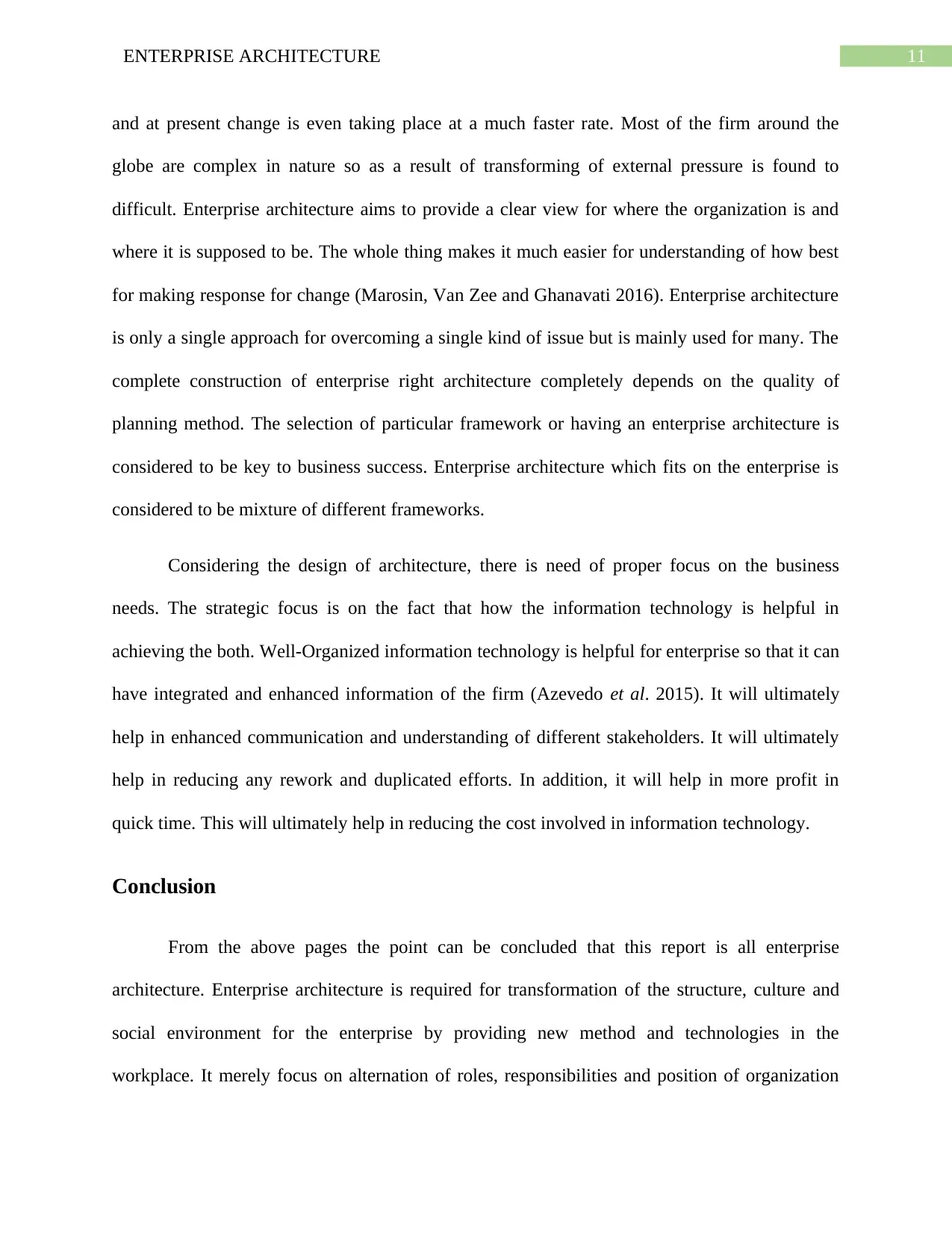
11ENTERPRISE ARCHITECTURE
and at present change is even taking place at a much faster rate. Most of the firm around the
globe are complex in nature so as a result of transforming of external pressure is found to
difficult. Enterprise architecture aims to provide a clear view for where the organization is and
where it is supposed to be. The whole thing makes it much easier for understanding of how best
for making response for change (Marosin, Van Zee and Ghanavati 2016). Enterprise architecture
is only a single approach for overcoming a single kind of issue but is mainly used for many. The
complete construction of enterprise right architecture completely depends on the quality of
planning method. The selection of particular framework or having an enterprise architecture is
considered to be key to business success. Enterprise architecture which fits on the enterprise is
considered to be mixture of different frameworks.
Considering the design of architecture, there is need of proper focus on the business
needs. The strategic focus is on the fact that how the information technology is helpful in
achieving the both. Well-Organized information technology is helpful for enterprise so that it can
have integrated and enhanced information of the firm (Azevedo et al. 2015). It will ultimately
help in enhanced communication and understanding of different stakeholders. It will ultimately
help in reducing any rework and duplicated efforts. In addition, it will help in more profit in
quick time. This will ultimately help in reducing the cost involved in information technology.
Conclusion
From the above pages the point can be concluded that this report is all enterprise
architecture. Enterprise architecture is required for transformation of the structure, culture and
social environment for the enterprise by providing new method and technologies in the
workplace. It merely focus on alternation of roles, responsibilities and position of organization
and at present change is even taking place at a much faster rate. Most of the firm around the
globe are complex in nature so as a result of transforming of external pressure is found to
difficult. Enterprise architecture aims to provide a clear view for where the organization is and
where it is supposed to be. The whole thing makes it much easier for understanding of how best
for making response for change (Marosin, Van Zee and Ghanavati 2016). Enterprise architecture
is only a single approach for overcoming a single kind of issue but is mainly used for many. The
complete construction of enterprise right architecture completely depends on the quality of
planning method. The selection of particular framework or having an enterprise architecture is
considered to be key to business success. Enterprise architecture which fits on the enterprise is
considered to be mixture of different frameworks.
Considering the design of architecture, there is need of proper focus on the business
needs. The strategic focus is on the fact that how the information technology is helpful in
achieving the both. Well-Organized information technology is helpful for enterprise so that it can
have integrated and enhanced information of the firm (Azevedo et al. 2015). It will ultimately
help in enhanced communication and understanding of different stakeholders. It will ultimately
help in reducing any rework and duplicated efforts. In addition, it will help in more profit in
quick time. This will ultimately help in reducing the cost involved in information technology.
Conclusion
From the above pages the point can be concluded that this report is all enterprise
architecture. Enterprise architecture is required for transformation of the structure, culture and
social environment for the enterprise by providing new method and technologies in the
workplace. It merely focus on alternation of roles, responsibilities and position of organization
⊘ This is a preview!⊘
Do you want full access?
Subscribe today to unlock all pages.

Trusted by 1+ million students worldwide
1 out of 17
Related Documents
Your All-in-One AI-Powered Toolkit for Academic Success.
+13062052269
info@desklib.com
Available 24*7 on WhatsApp / Email
![[object Object]](/_next/static/media/star-bottom.7253800d.svg)
Unlock your academic potential
Copyright © 2020–2025 A2Z Services. All Rights Reserved. Developed and managed by ZUCOL.





